GMC YUKON DENALI 2003 Owners Manual
Manufacturer: GMC, Model Year: 2003, Model line: YUKON DENALI, Model: GMC YUKON DENALI 2003Pages: 447, PDF Size: 21.97 MB
Page 91 of 447
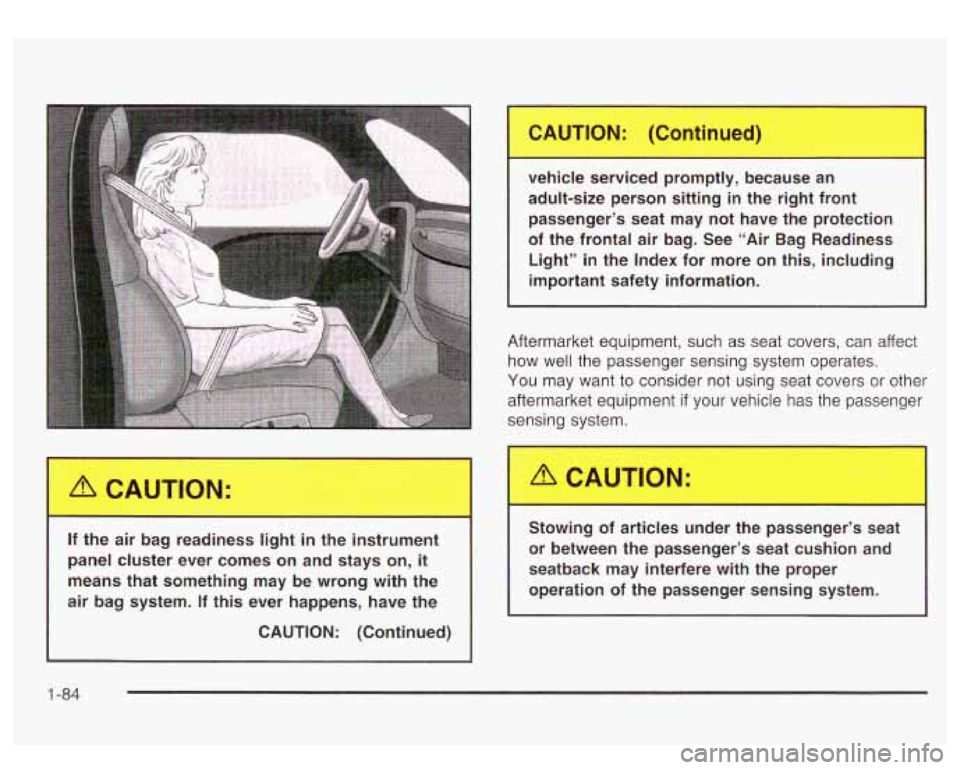
/r CAUTION:
If the air bag readiness light in the instrument
panel cluster ever comes on and stays on,
it
means that something may be wrong with the
air bag system. If this ever happens, have the
CAUTION: (Continued)
CAUTION:
u icle servicc- prom. y, because an
adult-size person sitting in the right front passenger’s seat may not have the protection
of the frontal air bag. See “Air Bag Readiness
Light”
in the Index for more on this, including
important safety information.
Aftermarket equipment, such as seat covers, can affect
how well the passenger sensing system operates.
You may want to consider not using seat covers or other
aftermarket equipment
if your vehicle has the passenger
sensing system.
Stowing of articles under
th -3assenger’s seat
or between the passenger’s seat cushion and
seatback may interfere with the proper
operation of the passenger sensing system.
1 -84
Page 92 of 447
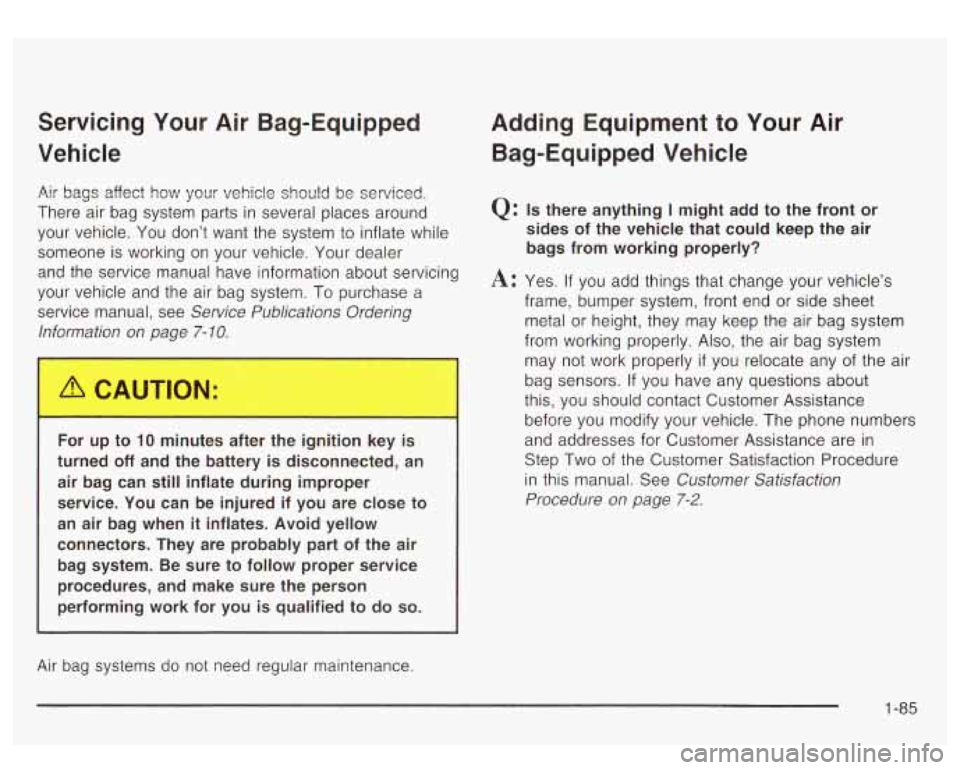
.I L
a
L
3
c n
Page 93 of 447
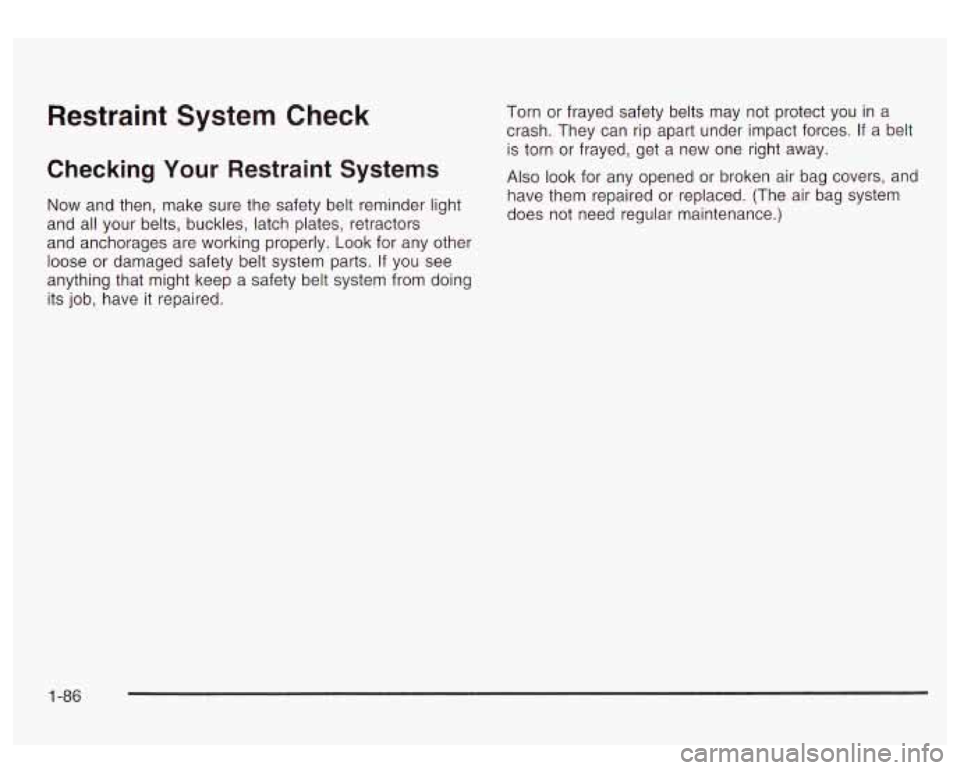
Restraint System Check
Checking Your Restraint Systems
Now and then, make sure the safety belt reminder light
and all your belts, buckles, latch plates, retractors
and anchorages are working properly. Look for any other
loose or damaged safety belt system parts. If you see
anything that might keep a safety belt system from doing
its job, have it repaired. Torn
or frayed safety belts may not protect you in a
crash. They can rip apart under impact forces. If a belt
is torn or frayed, get a new one right away.
Also look for any opened or broken air bag covers, and
have them repaired or replaced. (The air bag system
does not need regular maintenance.)
1 -86
Page 94 of 447
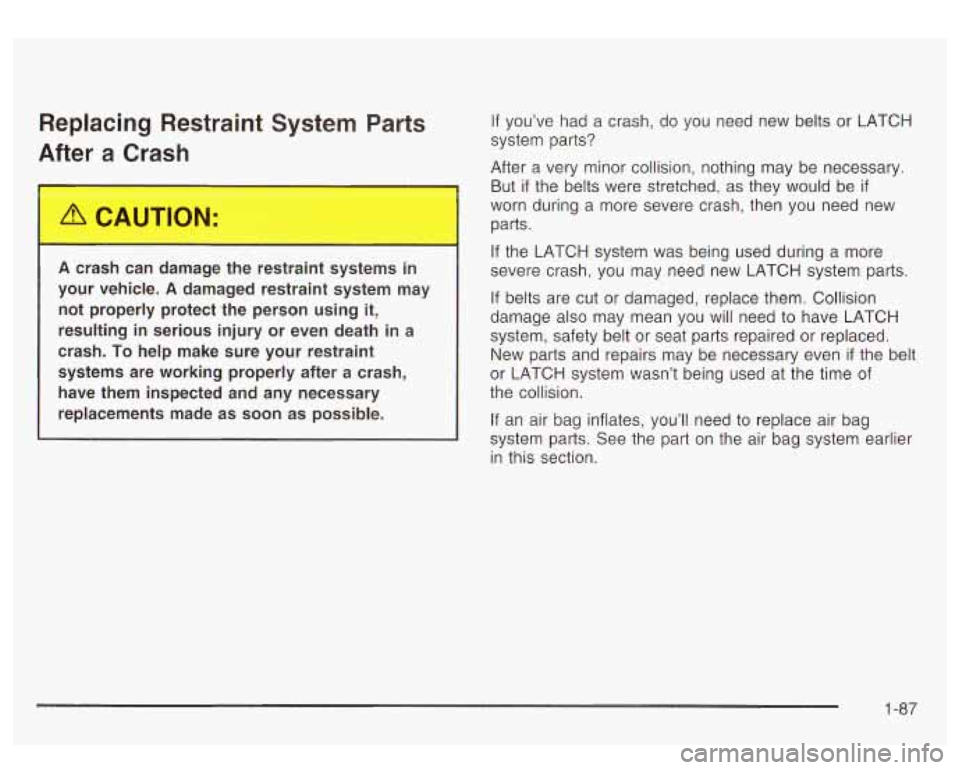
Replacing Restraint System Parts
After a Crash
A crash can damage the restraini ystems in
your vehicle.
A damaged restraint system may
not properly protect the person using
it,
resulting in serious injury or even death in a
crash.
To help make sure your restraint
systems are working properly after a crash,
have them inspected and any necessary
replacements made as
soon as possible. If
you’ve had a crash, do
YOU need new belts or LATCH
system parts?
After a very minor collision, nothing may be necessary.
But
if the belts were stretched, as they would be if
worn during a more severe crash, then you need new
parts.
If the LATCH system was being used during a more
severe crash, you may need new LATCH system parts.
If belts are cut or damaged, replace them. Collision
damage also may mean you will need to have LATCH
system, safety belt or seat parts repaired or replaced.
New parts and repairs may be necessary even
if the belt
or LATCH system wasn’t being used at the time of
the collision.
If an air bag inflates, you’ll need to replace air bag
system parts. See the part on the air bag system earlier
in this section.
1-87
Page 95 of 447

Page 96 of 447
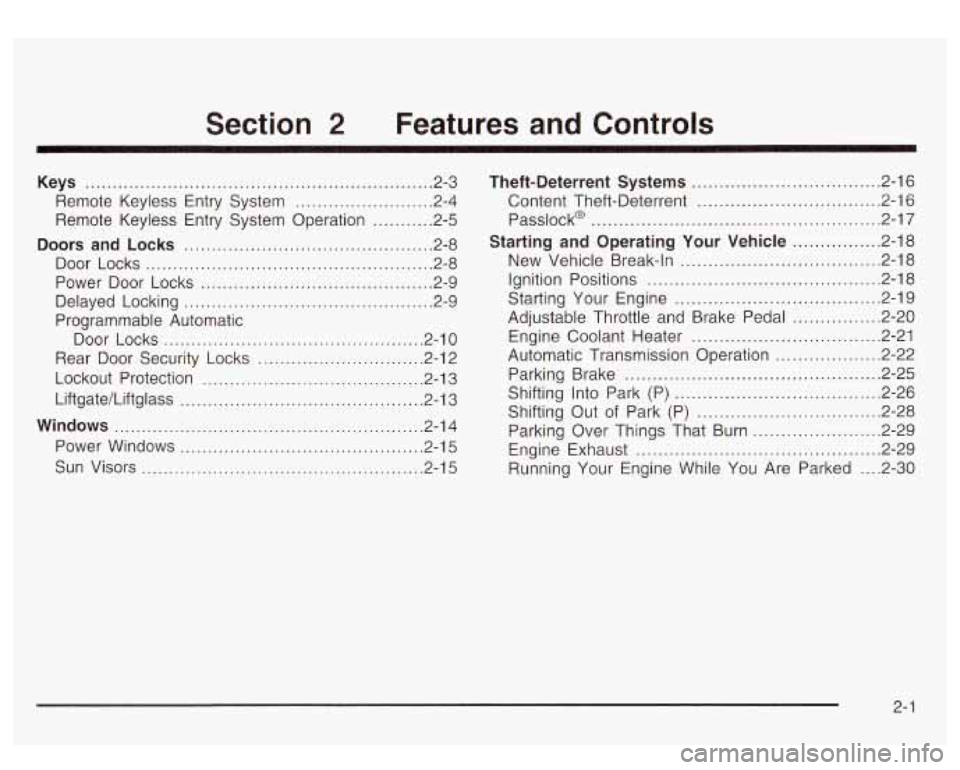
Section 2 Features and Controls
Keys ............................................................... 2.3
Remote Keyless Entry System
......................... 2.4
Remote Keyless Entry System Operation
........... 2.5
Doors and Locks ............................................. 2.8
Door Locks
................................................. 2.8
Power Door Locks
.......... .... ............. 2.9
Delayed Locking
............................................. 2.9
Programmable Automatic
Door Locks
............................................... 2.10
Rear Door Security Locks
.............................. 2.12
Lockout Protection
........................................ 2.13
LiftgateILiftglass
..................................... 2.13
Windows ........................................................ 2.14
Power Windows
............................................ 2.15
Sun Visors
................................................... 2.15
Theft-Deterrent Systems .................................. 2.16
Content Theft-Deterrent
................................. 2.16
Passlock@
.................................................... 2.17
Starting and Operating Your Vehicle ................ 2.18
New Vehicle Break-In
.................................... 2-18
Starting Your Engine
..................................... 2.19
Engine Coolant Heater
.................................. 2.21
Automatic Transmission Operation
................... 2.22
Shifting Into Park (P)
................. , ........ 2.26
Shifting Out of Park (P)
..................... , ........ 2-28
Parking Over Things That Burn
....................... 2-29
Engine Exhaust
............................................ 2.29
Running Your Engine While You Are Parked
.... 2-30
Ignition Positions
.......................................... 2.18
Adjustable Throttle and Brake Pedal
............... -2-20
Parking Brake
.............................. ..... 2.25
2-
1
Page 97 of 447
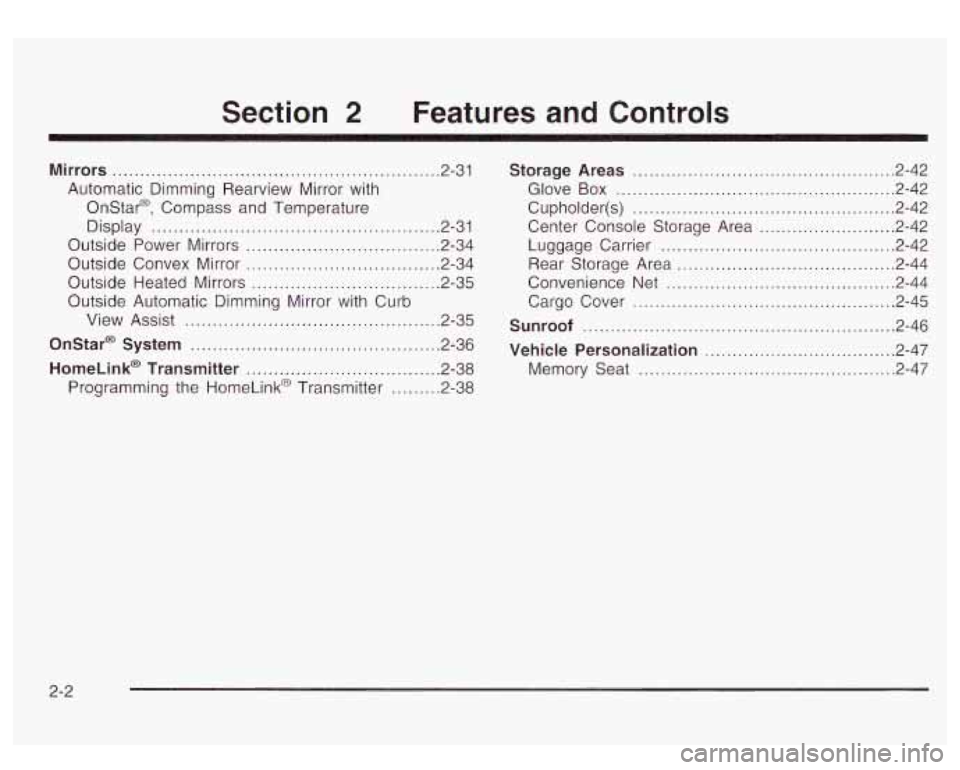
Section 2 Features and Controls
Mirrors ........................................................... 2-31
Automatic Dimming Rearview Mirror with
Onstar@. Compass and Temperature
Display
.................................................... 2.31
Outside Power Mirrors
................................... 2.34
Outside Convex Mirror
................................... 2.34
Outside Heated Mirrors
.................................. 2.35
Outside Automatic Dimming Mirror with Curb
View Assist
.............................................. 2.35
Onstar@ System ............................................. 2.36
HomeLink@ Transmitter ................................... 2.38
Programming the HomeLinkO Transmitter
......... 2.38
Storage Areas ................................................ 2.42
Glove Box
................................................... 2-42
Cupholder(s)
................................................ 2-42
Center Console Storage Area
......................... 2-42
Luggage Carrier
........................................... 2.42
Rear Storage Area
........................................ 2.44
Convenience
Net .......................................... 2.44
Cargo Cover
................................................ 2.45
Sunroof ......................................................... 2.46
Vehicle Personalization ............ ............... 2.47
Memory Seat
........................................... 2.47
2-2
Page 98 of 447

Keys
key is dangerous for many reasons. A child or
others could be badly injured or even killed.
They could operate the power windows or
other controls or even make the vehicle move.
Don't leave the keys in a vehicle with children.
2-3
Page 99 of 447
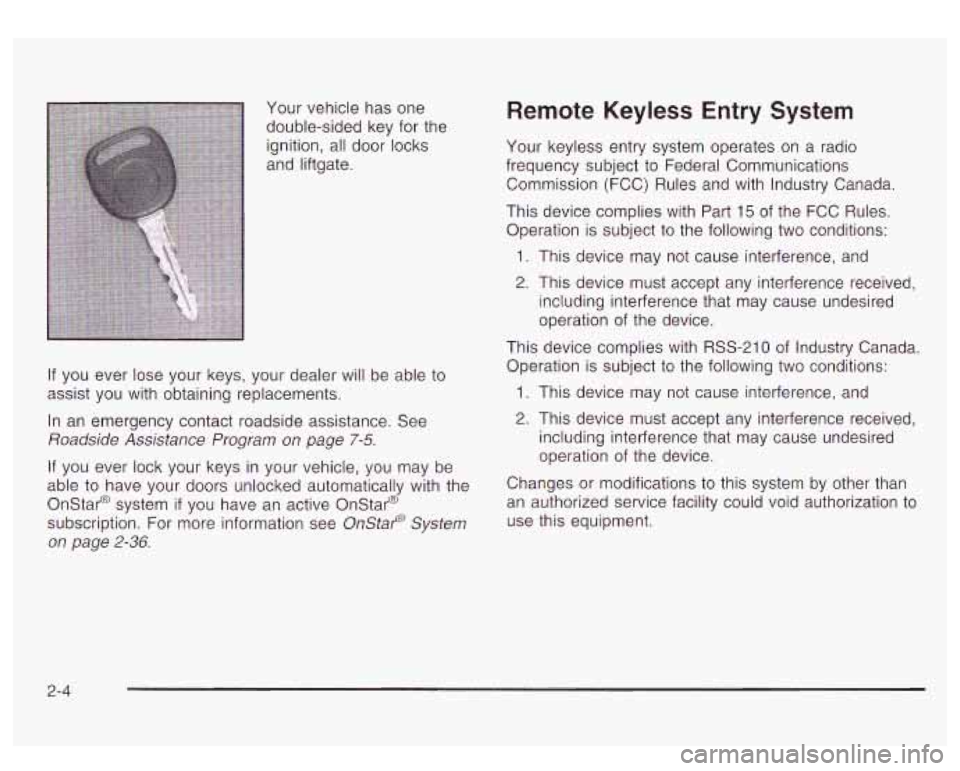
Your vehicle has one
double-sided key for the
ignition, all door locks
and liftgate.
If you ever lose your keys, your dealer will be able to
assist you with obtaining replacements.
In an emergency contact roadside assistance. See
Roadside Assistance Program on page
7-5.
If you ever lock your keys in your vehicle, you may be
able to have your doors unlocked automatically with the
Onstar@ system
if you have an active Onstar@
subscription. For more information see OnStap System
on page
2-36.
Remote Keyless Entry System
Your keyless entry system operates on a radio
frequency subject
to Federal Communications
Commission
(FCC) Rules and with Industry Canada.
This device complies with Part
15 of the FCC Rules.
Operation is subject
to the following two conditions:
1. This device may not cause interference, and
2. This device must accept any interference received,
including interference that may cause undesired
operation of the device.
This device complies with
RSS-210 of Industry Canada.
Operation is subject
to the following two conditions:
1. This device may not cause interference, and
2. This device must accept any interference received,
including interference that may cause undesired
operation of the device.
Changes or modifications
to this system by other than
an authorized service facility could void authorization
to
use this equipment.
2-4
Page 100 of 447

At times you may notice a decrease in range. This is
normal for any remote keyless entry system. If the
transmitter does not work or
if you have to stand closer
to your vehicle for the transmitter to work, try this:
e
e
e
Check the distance. You may be too far from your
vehicle. You may need to stand closer during
rainy or snowy weather.
Check the location. Other vehicles or objects may
be blocking the signal. Take a few steps
to the
left or right, hold the transmitter higher, and
try again.
Check
to determine if battery replacement is
necessary. See “Battery Replacement” under
Remote Keyless Entry System Operation on
page
2-5.
If you are still having trouble, see your dealer or a
qualified technician for service.
Remote Keyless Entry System
Operation
You can lock and unlock your doors from about 3 feet
(1 m) up to 100 feet (30 m) away using the remote
keyless entry transmitter supplied with your vehicle.
a (Unlock): Pressing this
button once will unlock the
driver’s door. The interior
lamps will come on.
Pressing unlock again
within three seconds will
cause the remaining doors
to unlock.
You can choose different feedback options for each
press of the unlock button, such as having the vehicle’s
perimeter lamps come on and/or having the horn
chirp. See
DIC Operation and Displays on page 3-43 for
more information.
2-5